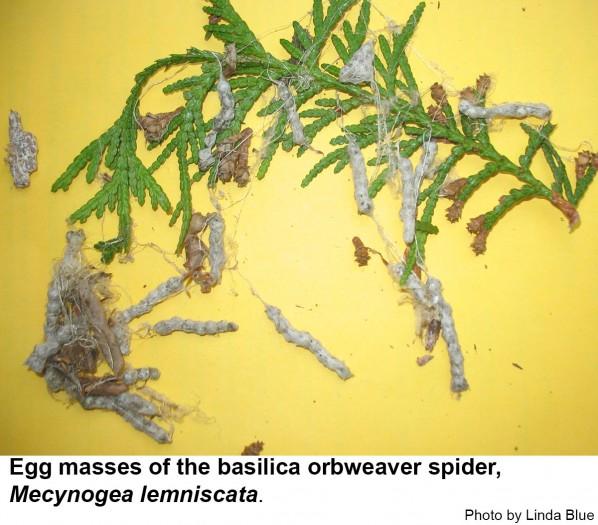Description and Biology
The basilica orbweaver spider, Mecynogea lemniscata, has a body about half inch long. It is brown except for the top of the abdomen that has lengthwise outer white wavy lines with narrow red bands just inside and black and yellow markings in the middle. It is named "basilica" because of its web part of which is dome shaped. The whole web may be 20 inches across. Its spiderlings weave perfect orb webs. As they mature, spiderlings tend to spin more specialized webs characteristic of adults. Like many of the orbweaving spiders, it removes its web at the start of each day (It seems to me like a lot of effort to have to spin a new web each night!). But the basilica orbweaver spider removes her web with a different twist. This spider wraps the old web tightly around her egg mass each time she lays a batch of eggs. These egg masses come to resemble strings of beads or silken tubes with “beads” of egg masses within. Orb weaver spiders have eight tiny eyes, but they are reputed to have poor vision. They locate their prey by the vibrations of the web caused by the struggles of their hapless prey.
Host Plants
Basilica orbweaver spiders do not feed on plants. Their only “damage” is the alarm caused by walking into a web during the night, or by the egg masses that might be considered unsightly. On the other hand, because spiders feed primarily on insects, they can be considered beneficial.
Residential Recommendation
Orthene is toxic to spiders and is labeled for landscape use should one decide to spray.
References
- Species Mecynogea lemniscata - Basilica Orbweaver. Bartlett, T. 2004. Additional contributions by "Lynette, kschnei, ceiseman." Bug Guide. Iowa State University Entomology.
- Spiders and their Kin. Golden Press. Levi, H. W. et al. 2001. Golden Guides from St. Martin's Press
- Extension Plant Pathology Publications and Factsheets
- Horticultural Science Publications
- North Carolina Agricultural Chemicals Manual
For assistance with a specific problem, contact your local N.C. Cooperative Extension Center
This Factsheet has not been peer reviewed.
Publication date: Dec. 3, 2012
Reviewed/Revised: Oct. 9, 2019
Recommendations for the use of agricultural chemicals are included in this publication as a convenience to the reader. The use of brand names and any mention or listing of commercial products or services in this publication does not imply endorsement by NC State University or N.C. A&T State University nor discrimination against similar products or services not mentioned. Individuals who use agricultural chemicals are responsible for ensuring that the intended use complies with current regulations and conforms to the product label. Be sure to obtain current information about usage regulations and examine a current product label before applying any chemical. For assistance, contact your local N.C. Cooperative Extension county center.
N.C. Cooperative Extension prohibits discrimination and harassment regardless of age, color, disability, family and marital status, gender identity, national origin, political beliefs, race, religion, sex (including pregnancy), sexual orientation and veteran status.


